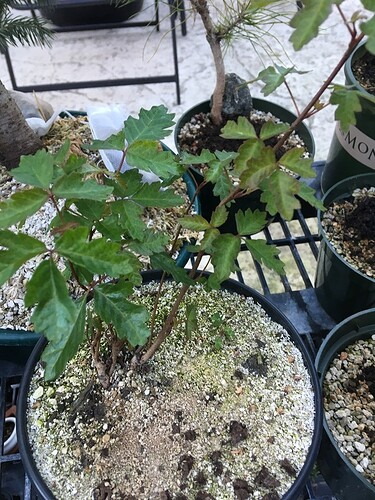Last fall I was cleaning out the volunteer plants in the yard when I spotted a couple of interesting little specimens that have been weed-whacked by the landscaper over the past couple of years. both were clumpish in form and I collected and repotted. I was sure one was a birch, but the other needed spring to reveal its identity. I had to laugh when the leaves emerged, I’m pretty sure it is a Toxicodendron diversilobum. Before I toss it in the green recycle bin, has anyone had or even tried making Toxicodendron diversilobum into a bonsai–is poison oak a native species that we could be exploring? Thoughts? ![]()
![]()
I guess if you have a macabre sense of humor you could turn it into a bonsai, but I can’t imagine it would be worthwhile. You’d have to get prepped every time you work on it (gloves, sleeves, eye protection, etc).
And if I remember correctly, it’s more of a vine than a shrub or tree. I don’t remember ever seeing a thickened trunk on one in the wild.
Oddly… someone in our local group presented a well trained specimine at last summers show. ( I won’t name names…)
Even though it was labeled, very few people recognized the oddity… I found it highly amusing.
I think I remember seeing a specimen in Nick Lenz’s book Bonsai from the wild. Styled similar to a scrawny vine maple or something. I’m super allergic to the stuff…good luck if you try to attempt it. I’m itching just thinking about it.
Before you begin, know that you’ll never be able to show it publicly. You’ll be creating chemical landmines wherever it is displayed. You’ll need a set of tools dedicated to it or you’ll need to thoroughly clean any tools you use. Urushiol is easily transferred from the plant to anything else. It’ll last on these objects for up to two weeks.
